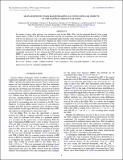Main-sequence stars masquerading as young stellar objects in the central molecular zone
Abstract
In contrast to most other galaxies, star formation rates in the Milky Way can be estimated directly from young stellar objects (YSOs). In the central molecular zone the star formation rate calculated from the number of YSOs with 24 μm emission is up to an order of magnitude higher than the value estimated from methods based on diffuse emission (such as free-free emission). Whether this effect is real or whether it indicates problems with either or both star formation rate measures is not currently known. In this paper, we investigate whether estimates based on YSOs could be heavily contaminated by more evolved objects such as main-sequence stars. We present radiative transfer models of YSOs and of main-sequence stars in a constant ambient medium which show that the main-sequence objects can indeed mimic YSOs at 24 μm. However, we show that in some cases the main-sequence models can be marginally resolved at 24 μm, whereas the YSO models are always unresolved. Based on the fraction of resolved MIPS 24 μm sources in the sample of YSOs previously used to compute the star formation rate, we estimate the fraction of misclassified "YSOs" to be at least 63%, which suggests that the star formation rate previously determined from YSOs is likely to beat least a factor of three too high.
Citation
Koepferl , C M , Robitaille , T P , Morales , E F E & Johnston , K G 2015 , ' Main-sequence stars masquerading as young stellar objects in the central molecular zone ' , Astrophysical Journal , vol. 799 , no. 1 , pp. 1-11 . https://doi.org/10.1088/0004-637X/799/1/53
Publication
Astrophysical Journal
Status
Peer reviewed
ISSN
0004-637XType
Journal article
Description
C.K. is a fellow of the International Max Planck Research School for Astronomy and Cosmic Physics (IMPRS) at the University of Heidelberg, Germany, and acknowledges support.Collections
Items in the St Andrews Research Repository are protected by copyright, with all rights reserved, unless otherwise indicated.

